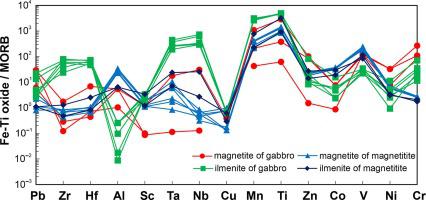Ore Geology Reviews ( IF 3.3 ) Pub Date : 2021-01-22 , DOI: 10.1016/j.oregeorev.2021.104005 Chirasree Bhattacharjee , Sisir K. Mondal

|
The Archean Mayurbhanj mafic complex in the Singhbhum Craton (eastern India) contains a magmatic Fe-Ti-(V) oxide ore deposit within a gabbro-norite-anorthosite suite of rocks. Immediate country rocks belong to the early Archean Gorumahisani greenstone belt and 3.1 Ga granitic complex. The gabbro-noritic rocks of the Mayurbhanj complex consist of plagioclase (An26−69), clinopyroxene (En42−54Fs4−36Wo22−42), and orthopyroxene (En67−81Fs15−28Wo4−5) as cumulus phases with Fe-Ti-oxides (magnetite and ilmenite) and sulfides (pyrite, pyrrhotite, chalcopyrite) as disseminated phases. Two-pyroxene thermometry yields temperatures of 1199 °C − 956 °C which are close to the primary liquidus temperature of pyroxene from a fractionated basaltic magma. The co-existing magnetite and ilmenite pairs in gabbro and magnetitite yield equilibrium temperatures of 498–797 °C and oxygen fugacities of 11.38–27.1 (log fO2) reflecting various stages of cooling and subsolidus re-equilibration of the mineral phases. Disseminated sulfides are mainly present along the grain boundaries of accessory Fe-Ti oxide grains, within interstitial spaces of silicate minerals, as inclusions within the silicate minerals and along altered fracture zones of the silicate host whereas the magnetitite bodies are devoid of such sulfide mineralization. In-situ trace element analysis of oxide and sulfide minerals from the gabbro-noritic rocks and magnetitite ores reveals a higher concentration of Cr (22301–67433 ppm) and Ni (896–3880 ppm) in the magnetite of gabbro than in the magnetitite bodies. This is due to early fractionation of the accessory magnetite in the gabbro from a Fe-rich basaltic magma. The lower concentration of V (30211–34608 ppm) in the accessory magnetite of the gabbro-noritic rocks than in the magnetitite (48534–64855 ppm) suggests partitioning of vanadium into clinopyroxene within the gabbroic rocks. Higher chalcophile element (Pb ≈ 2–11 ppm, Zn ≈ 6773–8139 ppm, Mo ≈ 25–68 ppm) concentrations in magnetite of the gabbro-noritic rocks indicate equilibration with co-magmatic sulfide mineral assemblages. The partitioning behavior of HFSE (Zr, Hf, Ta, Nb) in the magnetite and ilmenite is mainly dependent on the Ti4+ content of the minerals. The rim of iron-oxide minerals around sulfide grains and negative Ni anomaly in the trace element pattern of pyrite suggest that these pyrite grains have formed after pyrrhotite which is magmatic in origin. Enrichment of Pb (≈ 27–3120 ppm), Ag (≈ 8–15 ppm), Bi (≈ 0.2–9 ppm), As (≈ 48–6561 ppm), and Sb (≈ 0.4–18 ppm) in a few pyrites suggests hydrothermal alteration of primary magmatic pyrite grains.


























 京公网安备 11010802027423号
京公网安备 11010802027423号